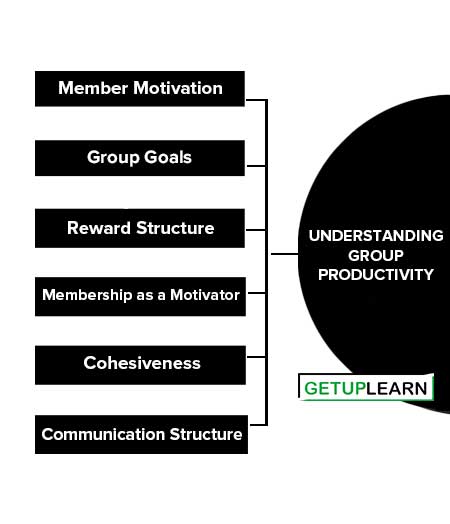Table of Contents
Understanding Group Productivity
The most crucial factor that can influence group productivity is the motivation of group members, group cohesiveness, and the group’s communication structure:
- Member Motivation
- Group Goals
- Reward Structure
- Membership as a Motivator
- Cohesiveness
- Communication Structure

Member Motivation
Effectively enhancing the motivation of group members can improve group productivity. This is the key to getting individual group members to improve their own as well as group productivity.
Individual group members need Io to be motivated to work toward group objectives that are in line with organizational objectives.
Group Goals
A group as a whole will be motivated if its members share a belief that the group can achieve its objectives. They are most likely to believe this if the necessary resources are available, group members receive performance feedback, and the group has a history of successful performance.
Reward Structure
Another factor in group motivation is the way the organization structures its reward system. There are two types of reward systems:
- A cooperative group reward is one that is tied to the group’s overall performance, with each group member receiving the same reward. This type of reward does not recognize differences in the extent to which each individual contributes to the group’s success. However, when the nature of the task makes contributions highly interdependent, cooperative group rewards play an important role in fostering the necessary cooperation and coordination.
- Competitive group reward is a system of rewarding individual group members for successfully performing as individuals within the group. The system tries to structure rewards equitably to reflect each person’s actual contributions to the group’s success. Underlying this system is an assumption that for the group to do its best each member must do his or her best and this performance should be recognized and rewarded.
Membership as a Motivator
If group members strongly identify with a group, they will be motivated to adhere to its norms. If the group’s norms support effective and efficient performance, the organization benefits.
Cohesiveness
Cohesiveness enhances productivity only when the group’s norms are consistent with the organization’s norms. If a group has low productivity norms, the organization is better off if the group is not cohesive. If a manager observes that a group has high productivity norms, the manager should foster cohesiveness.
This basically entails making group participation rewarding. Giving the group recognition for its successes can reinforce pride or belong to the group. Encouraging frequent interaction among group members helps build understanding and closeness within the group. When appropriate, cooperative group rewards can further strengthen cohesiveness.
Communication Structure
A group’s communication structure includes the directions in which communications flow within the group and the media used for sending messages.
Managers can improve group performance by providing access to communication media that facilitates communication among group members and by fostering a communication network suited to the group’s tasks.
To make the most of these efforts, managers must create an environment that encourages and recognizes communication from employees regardless of individual differences.
Management Can Adopt Two Approaches
Structural Approach
The structural approach deals with designing the formal organization in such a way as to be sympathetic to the informal organization. This can be achieved in the following ways:
- The work should be assigned in terms of “meaningful end-products”. This will enable group members to see their contributions directly and encourage them to associate themselves more closely with the work.
- People with all the skills necessary to complete the assigned work should be placed as close as possible to the point of action.
- An operating unit should be supplied with full facts on, its work. Since the unit receives the information promptly on its progress and has full authority to make changes, its members may become so engrossed with the result that they will avoid other social groups.
Behavioral Approach
Managers can adopt a flexible and accommodating approach towards informal organizations rather than a strong repressive approach to solve a problem arising out of its functioning. This can be achieved in the following ways:
- Management should reassure people that it is not against the informal organization.
- While making decisions like creating committees, changing work structure, etc., the influence of informal organizations should be taken into account.
Management can refrain from taking such action or creating the sort of environment, which is unnecessarily threatening to the informal organization.
